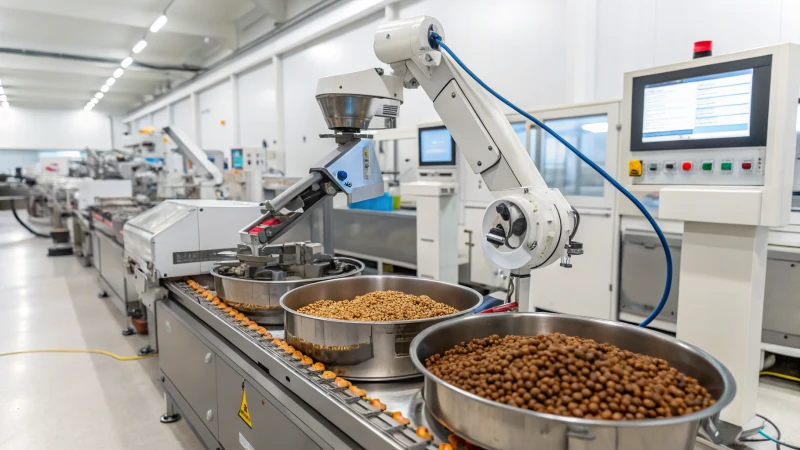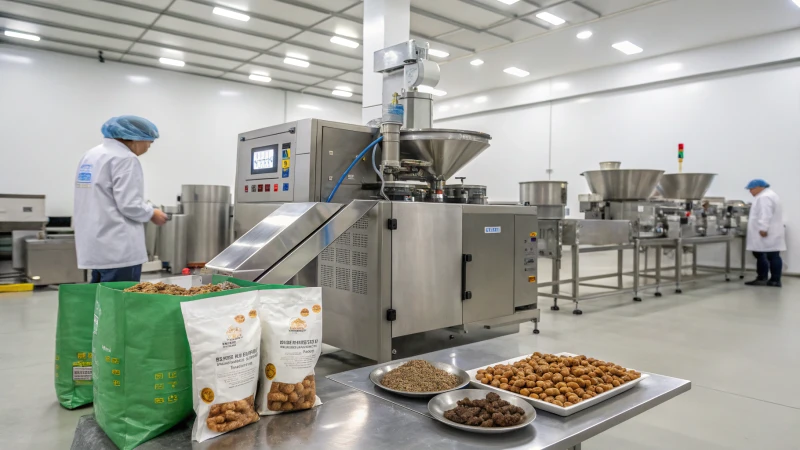
Maximizing production efficiency in pet food manufacturing, particularly with a dog food machine, is crucial for meeting increasing market demands while maintaining product quality and minimizing costs. Inefficient production processes often result in high energy consumption, inconsistent product quality, machine downtime, and increased waste—leading to lost profits and reduced competitiveness. However, by fine-tuning every aspect of your dog food machine operation, from raw material preparation to extruding and drying, you can significantly improve output and streamline your processes. This article will guide you through practical, actionable strategies to optimize your dog food machine's production efficiency.
Optimizing production efficiency with a dog food machine involves adjusting key parameters such as raw material formulation, extruder settings (temperature, pressure, screw speed), moisture control, automated feeding systems, and maintenance schedules. Implementing process automation, real-time monitoring, and energy-efficient drying techniques can improve throughput, reduce waste, and ensure consistent product quality.
Interested in learning how each adjustment and strategy can specifically enhance your dog food production process? Keep reading to discover detailed technical insights, real-world examples, and proven optimization methods tailored for dog food machine operations.
The screw speed of a dog food extruder affects the production capacity.True
Higher screw speeds increase throughput but need to be balanced to prevent over-shearing the raw materials, which can compromise pellet quality.
Key Factors Influencing Dog Food Machine Production Efficiency
Optimizing production efficiency in dog food manufacturing requires understanding several critical machine parameters and production stages. These include raw material handling, extrusion process, drying, cooling, and packaging.
Optimal Raw Material Formulation and Preparation
The formulation of raw materials directly affects extrusion efficiency and final product quality. Ingredients with the correct particle size, moisture content, and balanced nutritional profile ensure smooth processing.
Table 1: Ideal Raw Material Preparation Parameters for Dog Food Machine
| Parameter | Recommended Specification | Effect on Efficiency |
|---|---|---|
| Particle Size | 0.2 mm - 0.6 mm | Improves mixing uniformity and extrusion flow |
| Moisture Content | 18% - 22% | Ensures proper cooking, reduces energy consumption |
| Protein-Carb-Fiber Ratio | Balanced (as per product specification) | Maintains pellet structure and digestibility |
| Pre-mixing Time | 3-5 minutes | Ensures ingredient homogeneity |
Incorrect raw material preparation can lead to inconsistent extrusion pressure, frequent machine stoppages, and rejected batches.
Extruder Parameter Optimization: Temperature, Screw Speed, and Pressure
The extruder is the core component of a dog food machine. Adjusting key variables can significantly influence both output and quality.
Chart 1: Relationship Between Screw Speed, Temperature, and Throughput Rate
| Parameter | Recommended Range | Impact on Efficiency |
|---|---|---|
| Barrel Temperature | 100°C - 160°C | Controls cooking degree, prevents under/overcooking |
| Screw Speed | 300 rpm - 600 rpm | Higher speeds increase throughput but risk over-shearing |
| Die Pressure | 25 - 35 bar | Ensures pellet density and shape consistency |
| Feed Rate | Auto-adjusted with demand | Prevents bottlenecks and material buildup |
Real-time monitoring systems, integrated with the extruder, allow operators to automatically adjust these settings to respond to ingredient variations or environmental factors.
Efficient Drying and Cooling Techniques
Post-extrusion drying and cooling are crucial to reducing moisture content, ensuring long shelf life, and maintaining pellet quality.
Table 2: Drying System Efficiency Comparison
| Drying Method | Energy Consumption | Drying Time | Efficiency Advantage |
|---|---|---|---|
| Conventional Hot Air | High | 45-60 minutes | Simple, but high energy cost |
| Multi-Layer Belt Dryer | Medium | 25-35 minutes | Uniform drying, faster throughput |
| Microwave-Assisted Drying | Low to Medium | 10-15 minutes | Energy-saving, precise moisture control |
Installing multi-layer belt dryers integrated with humidity sensors allows better control, reducing energy waste and ensuring uniform moisture levels across all pellets.
Automation and Real-Time Monitoring Systems
Integrating automation solutions like programmable logic controllers (PLCs), human-machine interfaces (HMIs), and IoT-enabled sensors enables complete control of the dog food machine from raw material feeding to packaging.
Chart 2: Benefits of Automation in Dog Food Production

Automation advantages:
- 20%-30% reduction in labor costs
- 15%-20% improvement in overall equipment effectiveness (OEE)
- Consistent product quality due to minimized human error
- Faster response to process anomalies through real-time alerts
Preventive Maintenance and Machine Downtime Reduction
Neglecting regular maintenance leads to unexpected breakdowns, unplanned downtime, and lower production efficiency. Establishing a preventive maintenance schedule ensures machine longevity and operational continuity.
Table 3: Recommended Maintenance Checklist
| Frequency | Maintenance Task | Benefit |
|---|---|---|
| Daily | Clean die and screws, check lubricant levels | Prevents buildup, ensures smooth operation |
| Weekly | Inspect belts, sensors, and electrical components | Reduces risk of failure |
| Monthly | Check gearbox, replace worn-out parts | Maintains production efficiency |
| Quarterly | Full system calibration and performance testing | Ensures accurate, high-output performance |
Real-World Case Study: Dog Food Production Plant in Germany
A leading dog food manufacturer in Germany optimized their production line by implementing PLC-controlled extrusion systems, multi-layer dryers, and IoT-based monitoring. Results:
- 25% increase in production capacity
- 18% reduction in energy consumption
- Consistency in pellet shape and nutritional profile across all batches
- Downtime reduced by 30% due to predictive maintenance systems
This showcases how technology integration can offer measurable improvements in production efficiency.
Conclusion
Optimizing production efficiency with a dog food machine is a multifaceted process that requires fine-tuning raw material preparation, machine parameters, drying and cooling systems, and incorporating advanced automation and maintenance strategies. Each improvement compounds to create a streamlined, cost-effective, and high-output production system that meets market demand while ensuring consistent quality.
Contact Us for Tailored Dog Food Machine Solutions
Looking to enhance your dog food production efficiency? Contact us today for customized dog food machine solutions, technical consultations, and factory optimization services. Our expert team is ready to help you maximize output and minimize costs!
FAQ
How does a dog food machine improve production efficiency?
A dog food machine streamlines the manufacturing process by automating mixing, extrusion, and drying stages. This reduces manual labor, speeds up production cycles, and ensures consistent product quality, leading to higher output and lower operational costs.
What are the key factors to optimize dog food machine efficiency?
Key factors include regular machine maintenance, correct machine calibration, using high-quality raw materials, optimizing extrusion temperature, and training operators to handle the equipment efficiently. These factors ensure smooth operation and minimize downtime.
Why is automation important in dog food production?
Automation reduces human error, increases consistency, and allows for higher production volumes. It also reduces labor costs and improves safety, enabling manufacturers to meet market demand efficiently while maintaining product quality.
How can I reduce production costs with a dog food machine?
You can reduce costs by minimizing material waste, ensuring energy-efficient operations, scheduling preventive maintenance to avoid breakdowns, and investing in modern dog food machines with advanced technology for better output control.
Does machine calibration affect the quality of dog food?
Yes, proper calibration ensures that the machine produces kibble of consistent size, shape, and nutritional content. Miscalibration can lead to product defects, wasted materials, and increased production costs due to rework.
References
- Dog Food Production Line Overview - https://www.petfoodindustry.com/articles/8484 - Pet Food Industry
- The Importance of Automation in Pet Food Manufacturing - https://www.automationworld.com - Automation World
- Best Practices for Pet Food Extrusion - https://www.extru-techinc.com - Extru-Tech
- Reducing Costs in Pet Food Production - https://www.feedstrategy.com - Feed Strategy
- Improving Production Efficiency in Food Processing - https://www.foodengineeringmag.com - Food Engineering
- Maintenance Tips for Extrusion Machines - https://www.plasticsmachinerymagazine.com - Plastics Machinery Magazine
- Energy-Efficient Manufacturing for Pet Foods - https://www.energy.gov - U.S. Department of Energy
- The Role of Quality Control in Dog Food Production - https://www.foodqualityandsafety.com - Food Quality & Safety
- Advanced Technology in Pet Food Processing - https://www.petfoodprocessing.net - Pet Food Processing
- Operator Training for Efficient Machine Use - https://www.packagingstrategies.com - Packaging Strategies









